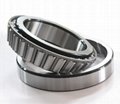Thrust Bearings and Tapered Roller Bearings: An Overview

In the world of rotating machinery, bearings are critical components that play a crucial role in ensuring smooth operation and extending the service life of machines. Bearings are devices designed to support radial and axial loads and reduce friction between moving parts. There are different types of bearings available in the market, tailored to meet specific requirements, depending on the nature of the application. Two commonly used bearing types are thrust bearings and tapered roller bearings.
Thrust Bearings
Thrust bearings, as the name suggests, are designed to handle axial loads, which are forces parallel to the axis of rotation. They are mostly used to support heavy loads, such as those encountered in turbines, pumps, and motors. Thrust bearings operate by transferring the axial load from the shaft to the bearing housing, which distributes the load evenly along the entire length of the bearing surface, reducing friction and wear.
There are different types of thrust bearings, each with its own unique design and application. Some of the most commonly used thrust bearings include ball thrust bearings, roller thrust bearings, and magnetic thrust bearings. Ball thrust bearings consist of two washers and a ball retainer, which allows for smooth rotation between the two surfaces. Roller thrust bearings, as the name suggests, have rollers instead of balls, which can handle heavier axial loads. Magnetic thrust bearings, on the other hand, use magnetic fields to support the axial load, eliminating the need for physical contact between the rotor and the stator.
Tapered Roller Bearings
Tapered roller bearings are primarily designed to support radial loads, which are forces perpendicular to the axis of rotation. They are used in a variety of applications, including automotive and industrial machinery. Tapered roller bearings consist of four main parts: the inner and outer rings, the rollers, and the cage. The rollers are tapered, which forms a cone shape, allowing for more contact between the rollers and the inner and outer rings. This design reduces friction and wear, resulting in smoother operation and longer service life.
Tapered roller bearings can be further classified into several types, depending on their design and application. These include single-row tapered roller bearings, double-row tapered roller bearings, and four-row tapered roller bearings. Single-row tapered roller bearings are the most commonly used type and are designed to handle both radial and axial loads. Double-row tapered roller bearings have a higher load-carrying capacity and are mostly used in applications where heavy radial loads are expected. Four-row tapered roller bearings are used in applications where even higher load-carrying capacity is required, such as automotive transmissions and railway wheels.
Conclusion
Thrust bearings and tapered roller bearings are two important types of bearings used in rotating machinery. While thrust bearings are designed to handle axial loads, tapered roller bearings are designed to support radial loads. Both types of bearings play a crucial role in ensuring smooth operation and extending the service life of machines. When selecting a bearing type, it is essential to consider factors such as load capacity, operating speed, and the nature of the application to ensure optimal performance and reliability.